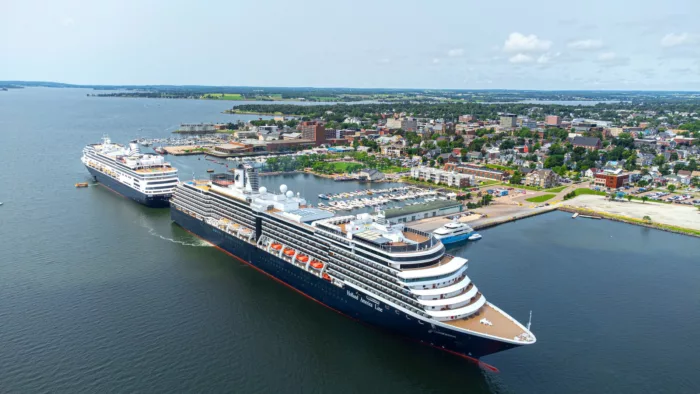Tales of the South Pacific from San Diego
One Night Hotel Stay In San Diego, 51 Nights' Full-board Cruise Onboard Zaandam
One Night Hotel Stay In San Diego, 51 Nights' Full-board Cruise Onboard Zaandam
- Departure Date: 28th September 2025
- Total Nights: 53 Nights
- Cruise: Zaandam
- Package Type: Cruise and Stay
- Includes Hotel Stay

Holland America Line, which has been sailing for 150 years, visits 400 ports in 114 countries every year. Dutch heritage shines through in some of the $4million-worth of artwork to be seen onboard, complimenting the luxurious cruise experience.
Live music remains HAL's forte, with venues including the Rolling Stone Rock room and BB King's Blues Club. For foodies, a wide range of restaurants serve the finest of fayre.
-
Return flights from UK
-
All transfers
-
One night four-star hotel stay in San Diego (in featured hotel or similar standard)
-
51 nights full-board cruise onboard Holland America Line's Zaandam





























Designed to carry fewer guests while offering greater space, Zaandam is elegant and comfortable. Her décor is inspired by music and features musical instruments including signed guitars from Queen, Iggy Pop, Eric Clapton and the Rolling Stones and a Baroque-style pipe organ.
Manchester Grand Hyatt
Similar package deals
South America Passage from San Antonio with Stay
- Includes hotel stay
- Includes outbound flight
- Includes inbound flight
- 18 nights, departs on the 19th Feb 2026
- 2nt Santiago hotel stay
- Flights & transfers included
- Have it All included
-
- Save £50 pp
- Cruise info: Holland America Line,
- Itinerary: Flight departs, Santiago Hotel Stay - 2 Nights, Cruise departs from Santiago +16 more
Canada Coast to Coast West Bound
- Includes hotel stay
- 18 nights, departs on the 30th May 2025
- Return flights from the UK
- Airport and port transfers
- One nights four-star hotel accommodation stay in Boston (in featured hotel or similar standard)
-
- Seven nights' full-board stateroom accommodation onboard Holland America Lines Zuiderdam
- One nights four-star hotel accommodation stay in Quebec (in featured hotel or similar standard)
- Via Rail Journey economy coach seat from Quebec to Montreal
- One nights four-star hotel accommodation stay in Montreal (in featured hotel or similar standard)
- Via Rail Journey economy coach seat from Montreal to Toronto
- Two nights four-star hotel accommodation stay in Toronto (in featured hotel or similar standard)
- Day trip to Niagara Falls
- Four nights' full-board private cabin Via Rail train Journey from Toronto to Vancouver
- One nights four-star hotel accommodation stay in Vancouver (in featured hotel or similar standard)
- Cruise info: Holland America Line,
- Itinerary: Fly UK to Boston, USA, Boston, USA, Halifax, Canada, USA +11 more
Alaska and via rail eastbound via Jasper
- Includes hotel stay
- Includes train travel
- 17 nights, departs on the 6th May 2025
- Return flights from UK
- Airport transfers
- Three nights' four-star hotel accommodation in Vancouver (in featured hotel or similar standard)
-
- Seven nights' full-board stateroom accommodation onboard Holland America Line, Zaandam
- Overnight Via rail journey between Vancouver,and Jasper in a private cabin on a full-board basis
- Two nights' hotel accommodation in Jasper (in featured hotel or similar standard)
- Bus transfer between Jasper and Banff
- Three nights' hotel accommodation in Banff (in featured hotel or similar standard)
- Bus transfer from Banff to Calgary airport
- Have it All, Signature Beverage Package, Wi-Fi, 1 x Speciality Dining & 1 x $100 shore excursion credit
- Cruise info: Holland America Line,
- Itinerary: Fly UK to Vancouver, Canada, Vancouver, Canada, Cruise the Inside Passage, Alaska +11 more
Hong Kong, The Philippines & Taiwan to Tokyo with Stays
- Includes hotel stay
- Includes outbound flight
- Includes inbound flight
- 20 nights, departs on the 13th Feb 2025
- 20 night Cruise & Stay package
- 14 night cruise onboard Noordam
- 2 night Hong Kong hotel stay
-
- 2 night Tokyo hotel stay
- Return flights from the UK
- Transfers
- Exclusive savings!
- Full board dining
- Upgrade To "Have It All" Available!
- Cruise info: Holland America Line,
- Itinerary: Fly from London Heathrow to Hong Kong Intl, Hong Kong Kowloon Hotel Stay - 2 Nights, Cruise departs from Hong Kong, China +15 more
Alaska Arctic Circle Solstice Cruise on Noordam
- Includes hotel stay
- 30 nights, departs on the 6th Jun 2026
- Return flights from the UK from various airports
- All transfers
- One night four-star accommodation stay in Seattle
-
- 28 nights full-board cruise onboard Holland America Line's Noordam
- Cruise info: Holland America Line,
- Itinerary: Fly from UK to Seattle, USA, Seattle, USA, Vancouver, Canada +24 more
Canary Island Enchantment Cruise
- 14 nights, departs on the 19th Apr 2025
- Start Your Journey Sale offer
- Free Stateroom Upgrade subject to availability
- $300 Onboard credit per stateroom
-
- Have It All premium package – includes signature beverage package, shore excursion spending money, speciality dining, surf wi-fi and pre paid crew appreciation.
- Cruise info: Holland America Line,
- Itinerary: Dover, Rotterdam, At Sea +9 more
Toronto, Niagara Falls & Rocky Mountaineer from Banff to Vancouver & Alaska with Inside Passage from Vancouver
- 15 nights, departs on the 20th Sep 2025
- Return flights included 'Have it All' upgrade included
- Free up to $400 Onboard Credit
- Hotel and transfers included
-
- Reduced Deposit!
- 'Have it All' upgrade included
- Cruise info: Holland America Line,
- Itinerary: Flight departs, Toronto Hotel Stay - 3 Nights, Toronto - Niagara Falls Full Day Tour +14 more
Canada and New England Maritime Cruise and 4th July stay
- Includes hotel stay
- 17 nights, departs on the 19th Jun 2025
- Return flights from the UK from various airports.
- All transfers
- Two nights' four-star accommodation stay in Montreal (in featured hotel or similar standard)
-
- 10 nights' full-board stateroom accommodation onboard Holland America Line's Voldendam
- Two nights' four-star accommodation stay in Boston (in featured hotel or similar standard)
- Freedom trail tour with Guide
- Cruise info: Holland America Line,
- Itinerary: Fly UK to Montreal, Canada, Montreal, Canada, Montreal, Canada +12 more













